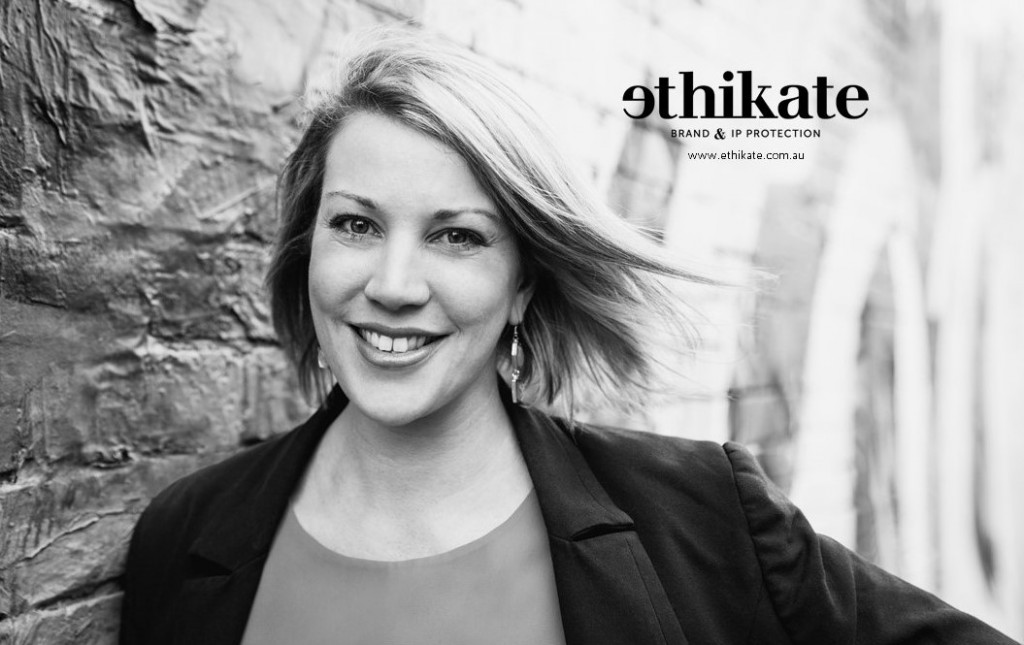
Ethikate’s Principal Lawyer and Trade Marks Attorney Kate Ritchie Explains Why Trade Mark Registration is Crucial for Small Businesses and Startups on 2UE Talking Lifestyle with David Koch.

The LIV awards program recognises law firms and individuals who advance the legal profession, contribute to the community, and demonstrate excellence in legal practice in Victoria. The winners were announced at a gala event on May 19, 2017.
The full list of finalists is available at the Law Institute of Victoria website.

However, as you probably know, an effective brand protection strategy goes well beyond the trade mark registration phase. That’s why Ethikate is excited to launch our trade mark monitoring service for new and existing clients.
As part of this service, Ethikate will search the Australian Trade Marks Search System (ATMOSS) on a monthly basis for any new trade marks that may appear to be deceptively similar or conflicting to your trade mark. If any results are found, our specialist lawyers will provide a report with options and advice on how to proceed.
The cost? A highly affordable $225 plus GST per quarter.
If we haven’t met yet, why not book your first meeting online? Ethikate offers your first Consult at a reduced fee.
If you are an existing client who is keen to take advantage of this offer, please contact us for a follow-up consultation.
We would love to hear from you!

No matter how organised and motivated you are, it is an inescapable fact that you are restricted by the number of workable hours in a day.
Spending two hours a day answering emails or one day a week preparing invoices for customers, may not be the best use of your time. So what’s the answer? Well, perhaps it’s time to consider outsourcing some of your workload to other people.
Thanks to the internet and the rise in popularity of cloud-based workrooms and storage systems that can be accessed from anywhere in the world, almost any task can now be outsourced. There are plenty of highly experienced freelancers registered online at outsourcing platforms such as UpWork, who are willing to work for reasonable rates and take some of the more time-consuming jobs associated with business administration off your hands.
However, as with everything, there are both pros and cons, which must be considered before deciding which elements of your business are suitable for outsourcing.
Before you start planning an outsourcing strategy for your business, you should think carefully about what positions you need to fill, and what kinds of jobs are typically outsourced.
It is worth considering that generally, you will have more control over full-time employees than contractors and freelancers because they are committed primarily to you and your business. With freelancers, you could end up competing for their time with other clients.
The biggest issue with taking on employees is that they become a fixed cost to your business and you may not be able to fully utilise them on a full-time basis, whereas when you outsource you can manage your expenses in real time and adjust terms in line with your needs in a way you can’t with permanent employees.
If you are considering outsourcing for your business, you will also need to make sure your insurance covers it. Check your professional liability insurance policy to ensure that as well as employees, independent contractors are covered for any claims arising from business-related activities they perform on your behalf.
Here are some of the outsourcing pros and cons:
Pros
Cons
About the Author: Kate Ritchie is a strategically focused Principal Lawyer and Trade Marks Attorney with both commercial and business services and legal experience. Kate has broad ranging competency in all aspects of legal services including intellectual property law, brand protection, commercial and business transactions, negotiation and alternative dispute resolution, internet law, privacy, competition and consumer law and sports law. Kate has worked with top-tier commercial law firms such as Clayton Utz and high profile companies such as Thiess Pty Ltd and Tatts Group. Kate founded Ethikate in 2014 with a passion for providing specialist advice and services in Intellectual Property Law, Trade Marks and Brand Protection Strategies, business and commercial law and entertainment and media law for startups, entrepreneurs and small to medium businesses.
Kate’s interview with Chloe James covered business success, the legal sector, “disruption for disruption’s sake”, startups and small businesses.
Check out the full interview below.

With its many benefits as a manufacturing capital, China is notoriously one of the world’s infringement capitals, which is why it is crucial that business owners expanding there understand how to protect their Intellectual Property.
With its many benefits as a manufacturing capital, China is notoriously one of the world’s infringement capitals, which is why it is crucial that business owners expanding there understand how to protect their Intellectual Property.
I have just returned from China after visiting with a client and the trip reminded me of some of the key differences when it comes to IP protection between that country and Australia.
Most important are the differences in trade marking. Unlike Australia, China is a ‘first to register’ not a ‘first to use’ state. This means that even if you are the first to use a brand in China, unless it has been registered via the lodgement of a China trademark application, it is not protected. Therefore, anyone who is aware of your brand prior to its registration can obtain a trade mark and prevent you from using your product in China. This has caused headaches for well-known brands, including Tiffany & Co and Tesla.
Patent and design applications do not differ as significantly and the process is more comparable to Australia. In China, business owners have two patent options.
The first is an innovation patent that is equivalent to Australia’s standard patent and carries a term of 20 years. The second option is a utility or ‘mini’ patent, which carries a shorter term of 10 years. China’s utility patent option is somewhat comparable to Australia’s design registration system. It simply requires you to apply to register your design in China before you launch the product and the registration is valid for 10 years, the same as Australia.
Given counterfeit goods and cheap knock off products are commonplace, China is notorious for IP breaches and can be an extremely difficult country to do business in.
Ethikate offers a range of affordable packages specifically designed for startup founders and small businesses, including our $199 Initial Consult. If you have any questions about small business law, including Intellectual Property, Trade Marks and Brand Protection, feel free to get in touch. We’d love to hear from you!
 You want to have as much information as possible before you speak to a professional. Or maybe you feel totally unsure and want to know a little bit more about brand protection and the trade mark registration process.
You want to have as much information as possible before you speak to a professional. Or maybe you feel totally unsure and want to know a little bit more about brand protection and the trade mark registration process.
We get it. Knowledge is power and we are all about empowering our entrepreneurial clients. So to help you out, we’ve put together a list of the most commonly asked questions about brand protection and trade marks.

I’ve spoken at several events and even guest lectured at University. However, I don’t think I’ve ever been this excited to speak at an event.
The EPIC BUSINESS PLANNING SUMMIT 2015 has an amazing line-up of female entrepreneurs and successful businesswomen (yes, Lisa Messenger IS one of them!) willing to share their inside knowledge, experience and expertise with fellow ‘sisters’ who are savvy, driven and innovative.
What I really love about being a part of this event is the innovative yet practical focus of the agenda. Whilst there is undoubtedly an intention to inspire fellow women to unleash their inner entrepreneur, this is in no way an event that sells ‘hopes and dreams’. What the EPIC BUSINESS PLANNING SUMMIT hopes to achieve is to arm business savvy women with some practical tools every start-up and small business should, but often don’t, know about in order to succeed.
So what will I be speaking about at this EPIC BUSINESS PLANNING SUMMIT 2015?
In my experience, there is ‘some’ focus on investing in brand development when starting out. This is great but, if you don’t get it right at the start, you’re wasting your money.
Unfortunately brand protection is often misunderstood or forgotten about, until it’s too late…when your business suddenly lands in hot water.
I’m passionate about educating and empowering business women to get it right at the start, rather than investing a lot more time, energy and money into fixing it later on.
My goal by speaking at this event is to share my experience and technical expertise in the corporate world and as an IP lawyer, trade marks attorney and brand protection specialist to show fellow business women how they can derive the most value from their business by creating a brand that can actually be used, protected and enforced.
I will show attendees the difference between a good brand and a not so good brand and, why it is so important to get it right.
So, what are you waiting for? Get your early bird tickets here.
See you there!
Kate xx
Principal Lawyer, Trade Marks Attorney & Brand Protection Specialist


Over the past few weeks, we’ve considered what it takes to create a strong brand and how to protect it at home and overseas. In the final part of this series we’ll look at some of the ways you can implement your brand protection strategy and enforce your trademark rights.
As we’ve discussed, brand protection encompasses the measures taken to prevent someone from illegally making and selling a product, or offering services using a brand name owned by another company. A strong brand protection strategy will help to safeguard your most valuable asset, but you need to use it and enforce it decisively, or you will lose the protection and value in your brand, that you’ve worked so hard to build.
Fortunately, businesses can protect their brands by implementing various legal processes. We discuss some of these below.
As we discussed in part three, trademark registration is one of the most effective ways to protect your brand in the market. Once your trademark is registered you should consider using the ® trademark registration symbol on your branded material.
The trademark registration symbol ® can only be used for trademarks that registered in Australia. You can also use the trademark registration symbol in overseas markets, but your brand will need to be registered as a trademark in those countries and you need to ensure you are also are adhering to any local conventions. If you don’t have a registered trademark yet in Australia or in your overseas markets, then you can use the ™ symbol.
It is not compulsory to use the ® or the ™ symbol, but its inclusion will give your brand a sense of qualification and act as a deterrent for would be infringers.
Once you register a trademark you must use it in the form it is registered and for the goods and service for which it is registered, to prevent your trademark registration from becoming vulnerable to removal from the register, for non-use.
Anyone can apply for the removal of a trademark for non-use. It is then up to you as the trademark owner, to oppose the removal action and provide valid reasons for why you believe your trademark should remain registered. You will also need to produce satisfactory evidence in support of your opposition to the application for removal.
Diligent trademark owners should keep records of their use on file as this can be very useful not just to defend non-use actions but also to rely on as evidence of your reputation in your trademark, your prior rights and your ownership.
If you are allowing others to use your trademark, then it is important that you control that use. The most common way to control authorised use of a trademark is with a trademark licence. A good trademark licence will include details of the trademark or trademarks that can be used, how they can be used, where, when, the fee for the use and for what purpose the licensee can use the trademark. If you don’t control the authorised use of your trademark then you risk waiving your rights in the trademark.
Common licensees include manufacturers, sponsors, distributors and retailers, franchisees, contractors and consultants.
As a general rule, your brand protection strategy should include watching and monitoring.
Trademark monitoring involves systematically checking for newly filed trademark applications that are similar to your trademark registrations and may adversely affect the value of your brand, your business reputation and your trademark rights, should they be registered. Observing competitors in this way will allow to you to deal swiftly with any threats or infringements on your brand.
Trademark monitoring should also include inspection of business and company names, domain names, social media profiles, websites, directories and search engines, marketing and advertising material and published content such as blogs. Not only will online monitoring of your brand protect you from would be infringers of your trademarks, but can also mitigate your risk of infringing someone else’s. As well as protecting against online threats, monitoring your brand online can allow you to measure how your brand is performing and how effective your reach and impact is.
If you identify a particular brand or trademark that may be problematic for your business, then you should implement a trademark watching process that monitors a specific trademark application or brand.
If you suspect an individual or business of infringing on your brand, you can send a “cease and desist” letter. Also known as an infringement letter or a demand letter, they contain a warning and deadline to cease specified conduct and actions. Cease and desist letters can be an effective way of resolving potential issues before they have a chance to develop.
Be aware that there are risks in sending out a cease and desist letter including action being taken against you for groundless threats or misleading or deceptive conduct (to name but a few!). If you do wish to send one out, we urge you to engage a lawyer who is experienced in brand protection to do it for you. That way you invest a little bit of money upfront to save a lot of potential costs and liability if you get it wrong.
Another important strategy you can use to enforce your trademark rights is to oppose new trademark applications that conflict with your brand or otherwise should not be registered. The benefit of this is two-fold. The first being that you are preventing others (usually competitors) from devaluing your trademark rights and diluting your market presence. Secondly, you are saving yourself a lot of heartache if you decide to lodge new trademark applications that incorporate the conflicting trademark. What does this mean? If you allow your competitors to register a trademark that is similar to yours, it is more likely than not that future trademark applications that you wish to lodge for your brand will be stopped by your competitors trademark. What’s more, you won’t be able to enforce your rights against this competitor in the future. They now have a defence and you may be viewed as having waived your rights to action against them. This highlights the importance of understanding the potential costs and ramifications of not taking action to protect your brand and why it might be more cost effective (and valuable!) to take action.
An opposition kicks off by lodging a notice of intention to oppose a trademark application with the Australian Trademarks Office, within a 2 month opposition period. You will then have one month to lodge your statement of particulars which sets out the grounds of your opposition. If the applicant of the trademark defends the opposition, then you will enter opposition proceedings, notwithstanding the option of a cooling off period where the proceedings are suspended so that the parties can negotiate a settlement.
Oppositions, like any legal proceeding, can be scary for small business owners but they needn’t be. In my experience, by adopting a smart, upfront strategy to oppose, these proceedings typically go into a cooling off period whereby the parties can negotiate a sensible, commercial solution that, if successful, puts an end to the proceedings.
If all else fails, business owners can start court proceedings against the parties believed to be infringing on their brand and trademark rights. Proceedings can cover aspects such as trademark infringement, misleading or deceptive conduct, copyright infringement and passing off. Court proceedings should be a last resort only where previous attempts to resolve the matter have been unsuccessful.
For more information on how to protect against trademark infringement, misleading or deceptive conduct or passing off, read part two of this blog series.
As we’ve demonstrated, creating a strong brand protection strategy is essential in protecting your brand and assets, but you need to be proactive and willing to enforce it. Here at Ethikate we pride ourselves on being brand protection specialists. We can work with you to (1) create and implement a strong, tailored brand protection strategy; and (2) enforce your brand and trademark rights for you. Click here to find out more!

So far in this five-part series, we have discussed the importance of creating a strong brand protection strategy in order to safeguard your assets here in Australia.
But what happens when you decide to expand your business and tackle the global marketplace? This post considers some of the steps you’ll need to take to ensure you are protected and operating legally in your overseas markets.
Unfortunately, ‘global trade mark registration’ or ‘international trade mark registration’ does not exist, so you will need to undertake significant research on the laws and conventions of your chosen country to establish how best to protect your brand there. This is no easy task and in any case, you will almost always need to engage a lawyer or attorney either in Australia and/or in each of the overseas markets to assist you with this process.
You will also need to ensure that you are able to operate legally without infringing on any existing rights held by similar businesses within your industry, in each relevant overseas market. Trade mark registration is recognised on a per country basis, with the exceptions of Europe and Africa where regional trade mark registrations are also available.
Clearance checks and legal processes will need to be implemented; many of which are not dissimilar to those here in Australia, but they do vary. So, keep reading!
There are two options for overseas trade mark registration which we set out below.
This is a process of international registration under a treaty recognised as the Madrid Protocol. Australia is a party to the agreement under the Madrid Protocol. Hence, where you have filed a trade mark application in Australia, registering international trade marks under the Madrid Protocol involves filing a single international trade mark application directly to the Australia Trade Marks Office (IP Australia), designating which countries or regions of the Madrid Protocol you wish to be registered for, accompanied by the designated fees.
This is generally the most straightforward option as it is both time and cost-effective where you intend to register in more than one overseas market. However, one potential disadvantage of using the Madrid Protocol for international registrations is that, if your application in Australia fails to register, so too does your international registrations. Hence, you should be confident that your Australian trade mark application has good prospects of achieving registration before registering overseas using the Madrid Protocol.
It is also important to remember that any of the countries included in your Madrid Protocol application can choose to reject your registration request. If this happens, you will need to engage a qualified trade marks agent in that country to prosecute the trade mark application on your behalf. This can sometimes result in more cost to you than had you filed the application directly with those agents in the first place!
If you want to focus your international expansion on one or two overseas markets, you may decide to tailor your overseas protection strategy on a country-by-country basis. This can sometimes be tricky, as local laws and conventions can vary greatly. You will also need to engage a domestic lawyer or attorney in each of those countries who is qualified to file and prosecute the trade mark applications on your behalf. This option can become very expensive and time consuming if you wish to register in more than one or two overseas markets.
With regards to European protection, you can apply for a ‘Community Trademark’, which enables you to lodge a singular application for protection in all 27 EU member states. However, Community Trademarks by their nature are prone to opposition as conducting clearance searches in 27 countries is not generally feasible and so your risk of conflicting with similar marks in one or more of the EU member states can be quite significant.
Whichever option you use, it is also important to keep in mind that international conventions and each country have strict time limits and ‘priority dates’, and not all are the same.
Many countries and regions including China, Japan, German, Spain and Korea, operate on a ‘first to file’ basis. This means that the first person to file and successfully register a trade mark in those countries will be deemed the owner of that trade mark. This can create issues where you may have been using your trade mark in one of these countries, but didn’t register it straightaway. If someone else registers your trade mark in these countries first, it will be very difficult to claim your right of ownership. The owners of well-known brands such as Penfolds, Apple, Ferarri, Pfizer as well as celebrities including Justin Beiber and Michael Jordan are just some who have fallen victim to China’s trade mark ‘squatters’ as a result of China’s ‘first to file’ principle. Unless you have lots of time and money to start a brand war in China you will find it almost impossible to reclaim ownership of your brand in these countries. This is very different to Australia (and other countries such as the US and Canada) where prior use is recognised as a prior right of ownership of a brand, regardless of who files the trade mark application first.
Many countries allow you to extend your existing Australian registration and accept it as protected in that country after completing certain formalities. This is a result of these countries signing up to treaties and conventions such as the Paris Convention. Where you apply for protection in a contracting country of the Convention and then apply for protection in other contracting countries, within six months of the date you filed your original application, you can claim ‘priority’ so that protection for your trade marks in each contracting country will backdate to the original filing date of that first application.
Hence, if you file a trade mark application in Australia, you will have six months to file trade mark applications in other contracting countries such as the US, Canada or the UK and protection for these overseas trade marks will backdate to the date you first filed your trade mark application in Australia. For more information check out The World Intellectual Property Office (WIPO) website for the list of the 176 contracting countries to the Convention.
The Paris Convention doesn’t prevent you from filing a trade mark application overseas at a later date. However if you don’t file within the six month timeframe, your overseas trade mark applications will lose priority under the Convention. Hence, protection will only apply on and from the date you filed or registered the overseas application, depending on the local laws of that particular country. So it is important to consider your international brand protection strategy around the same time you file your Australian trade mark application.
In a word, yes! With the online world creating a global market for businesses of all shapes and sizes, international protection of your brand is more important than ever. So, if you are intending to promote and sell your goods or services in overseas markets (eg via your ecommerce website) then you need to ensure that you can do so freely and have the necessary protection in place, just as you do in Australia.
Choosing not to register and protect your interests outside of Australia allows the possibility for others to make use of your brand overseas and potentially harm your reputation and/or opportunities for international expansion.
Here are some factors to consider when deciding whether or not to protect your brand overseas:
Tackling overseas protection quite complex and therefore daunting for business owners, despite international treaties and conventions such as the Madrid Protocol. At Ethikate we are experienced and knowledgeable on overseas trade mark registrations and can offer specialist advice on how you can create a strong international brand protection strategy.
We will provide cost-effective, tailored solutions specific to your businesses’ expansion plans and can manage your international trade mark applications for you, right through to registration.
Contact us to speak to an experienced intellectual property lawyer and trade marks attorney about your international brand protection strategy today.

Ethikate is a boutique Australian law firm and trade marks attorney practice helping SMEs protect their brand and intellectual property. { More }
"Kate is an exceptionally intelligent person with a massive capacity to take on new concepts and challenges. Her dedication to her learning at Thiess demonstrated a strong drive to succeed. Her attitude is always positive and her ability to see issues and solutions clearly is one of her many strengths."
David McAdam, Managing Director & Chief Executive Officer, Seymour Whyte Constructions Pty Ltd